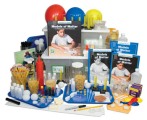13 Guidelines for Teaching About Posing Investigation Questions
December 13, 2013 at 5:07 pm Leave a comment
Posing investigation questions is the foundation for learning about the natural world, and posing questions that can be investigated is an important part of scientists’ work.
This article provides guidelines that can be used to teach about posing investigation questions related to the content in many science texts. Posing an investigation involves multiple steps, including asking a question, making predictions, planning the investigation, and observing what happens. Understanding how to come up with a question to guide scientific investigation is an important inquiry skill.
When students are taught how to pose their own investigation questions, they can better understand the ways in which scientists explore the natural world and generate new knowledge.
Here are Guidelines for Investigation Questions you can provide students:
Below are 13 Guidelines for Teaching About Posing Investigation Questions related to the content in many science texts:
- Select a text about a science topic that students could potentially investigate in the classroom. Topics could include plant growth, magnets, simple chemical reactions, phase change, or rocks and minerals. Texts about particular scientific investigations can also be used for this purpose, but it is not necessary that the text specifically mention investigations.
- Create a chart on the board listing guidelines for developing investigation questions. See the box above for sample.
- Explain to the class that scientists ask questions to learn about the natural world and that investigations always begin with asking questions.
- Have students read the text you selected. Tell students that as they read they should think about questions they are curious about that they would like to investigate.
- After students read the text, briefly discuss the main ideas. Then, ask students to share some questions they thought of during reading. Record these questions on the board.
- Explain that coming up with a question that can be investigated can be challenging, even for scientists. Tell students that the class will think about the questions they have generated and work to make them investigable.
- Select one of the student-generated questions that does not require too many revisions to make it an investigable question. Circle this question on the board.
- Read over the Guidelines for Investigation Questions and let students know that by checking their questions against these guidelines, students can revise their questions to make them more suitable for investigation.
- Reread the guidelines one by one and determine if the question you selected meets the guidelines or if it requires some revision. Ask the class for input as you use the guidelines to revise the question.
- Let the class know that they will complete this same process with questions of their choice. Arrange students into pairs or small groups so they can discuss their questions.
- Explain that students should agree upon one question to discuss. Say that they may think of new questions, or they may draw from the questions on the board. Give students time to select a question.
- Once groups choose their questions, have groups check them against each of the guidelines and revise them as needed.
- Ask students to share their revised questions. Confirm that the questions meet the guidelines. Discuss how students could investigate these questions. If possible, give students a chance to carry out these investigations.
Click here to download the Posing Investigation Questions Strategy Guide, including printable copymaster.
For more information about Seeds of Science/Roots of Reading Strategy Guides, covering a variety of powerful instructional strategies from the Seeds of Science/Roots of Reading integrated curriculum, visit http://www.scienceandliteracy.org/teachersupport/strategyguides
Do you want to be notified when we publish new blog articles? Simply enter your email address in the “Follow Blog via Email” box located in the right sidebar.
Entry filed under: Informational text, Strategy Guide. Tags: elementary curriculum, elementary lesson plans, Investigation questions, literacy.





Trackback this post | Subscribe to the comments via RSS Feed